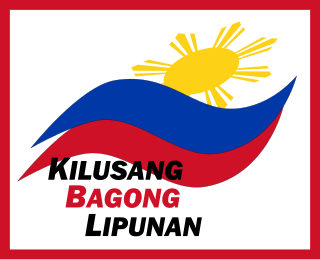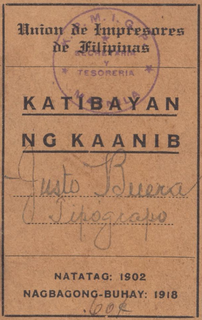Related Research Articles

Gregorio Aglipay Cruz y Labayán was a former Filipino Catholic priest who became the first head of the Iglesia Filipina Independiente, an independent Church in the form of a national church in the Philippines.

The Communist Party of the Philippines is a far-left, Marxist-Leninist-Maoist revolutionary organization and communist party in the Philippines, formed by Jose Maria Sison on 26 December 1968. It is designated as a terrorist group by the United States Department of State through Executive Order No. 13224 together with Sison and the New People's Army (NPA) in 2002. The European Union, through Council Decision (CSFP) 2019/1341, renewed the terrorist designation of the CPP-NPA in 2019, though the European Union's second highest court ruled in September 2009 to delist Sison as a "person supporting terrorism" and reversed a decision by member governments to freeze assets. According to the US' Central Intelligence Agency (CIA) World Factbook, the CPP and its armed wing, the NPA, aims to destabilize the Philippines' economy and overthrow the national government.

The New Society Movement, formerly named the New Society Movement of United Nationalists, Liberals, et cetera, is a right-wing to far-right political party in the Philippines. It was first formed in 1978 as an umbrella coalition of parties supporting then-President Ferdinand E. Marcos for the Interim Batasang Pambansa and was his political vehicle during his regime. It was reorganized as a political party in 1986, as the party furthest to the right of the political spectrum among the active parties after Marcos' ouster.
The Communist University of the Toilers of the East (KUTV) was a revolutionary training school for important Communist political leaders. The school operated under the umbrella of the Communist International and was in existence from 1921 until the late 1930s. Part of the university was split into the Moscow Sun Yat-sen University.

The 1935 Philippine presidential and vice presidential elections were held on September 16, 1935. This was the fourth election since the enactment of the Tydings–McDuffie Act, a law that paved the way for a transitory government, as well as the first nationwide at-large election ever held in the Philippines.
Crisanto Evangelista was a Filipino Communist politician and labor leader of the first half of the 20th century. He is credited as being one of the founders of the Partido Komunista ng Pilipinas. Evangelista was also an influential head of the Congreso Obrero de Filipinas, at the time the foremost and largest trade federation in the Philippines, having served as secretary for multiple years. He also headed the Union de Impresores de Filipinas as its Secretary-General. Prior to forming the PKP, Evangelista was a member of the Partido Obrero de Filipinas, a Filipino workers' party with increasingly radical leanings. Evangelista was eventually captured by the Japanese during the Second World War and executed.

Pedro Abad Santos y Basco was a Filipino politician. He founded the Partido Sosyalista ng Pilipinas (PSP) or Philippine Socialist Party in 1929. He ran for several local elections but never won. Luis Taruc of the Hukbalahap Rebellion was under his tutelage and was his right-hand man.

The Partido Komunista ng Pilipinas-1930 (PKP-1930), also known as the Philippine Communist Party, is a communist party in the Philippines that was established on November 7, 1930. It uses the aforementioned appellation in order to distinguish itself from its better known splinter group, the Communist Party of the Philippines.
Guillermo Capadocia (1909-1951) was a Filipino politician and labour leader. He was a prominent leader of the Communist Party in the Philippines (PKP) and different labour movements. During the last one and a half years of his life he was a regional guerrilla commander of the Hukbalahap.
The 1935 Philippine general election was the first general election of the Commonwealth of the Philippines. This was also the first direct election of the President of the Philippines and Vice President of the Philippines, positions created by the 1935 constitution. Furthermore, members of the National Assembly of the Philippines, that replaced the Philippine Legislature were elected.

Plaza Moriones is a major public square in Tondo, Manila. Unlike other squares in Manila, the plaza is in the shape of a linear park occupying the central median of Moriones Street, starting at the intersection of Moriones and Juan Luna Streets, and ending at the intersection with Santa Maria Street, bisected by Nicolas Zamora Street in the center. It is named after Governor-General Domingo Moriones y Muralla, responsible for the construction of Manila's sewerage system during his tenure from 1877 to 1881.
The history of communist armed conflicts in the Philippines is closely related to the history of Communism in the Philippines, with various armed conflict linked to the armed wings of the various communist organizations that have evolved since 1930. The two largest conflicts have been the Hukbalahap Rebellion of 1942–1954, which was initiated by the Partido Komunista ng Pilipinas of 1930 (PKP-1930) and its armed group the Hukbalahap (HMB), and the ongoing rebellion of the New People's Army, which began in 1969 under the auspices of the Communist Party of the Philippines. The latter conflict was still in its infancy in 1972 when Ferdinand Marcos proclaimed Martial law, but expanded significantly as even the moderate opposition against Marcos was radicalized.
Communism in the Philippines emerged in the first half of the 20th century during the American Colonial Era of the Philippines. Communist movements originated in labor unions and peasant groups. The communist movement has had multiple periods of popularity and relevance to the national affairs of the country, most notably during the Second World War and the Martial Law Era of the Philippines. Currently the communist movement is underground and considered an insurgent movement by the Armed Forces of the Philippines.
The First Great Rectification Movement refers to a 1965 ideological movement by Filipino communists led by Jose Maria Sison wherein they "criticized, repudiated and rectified the major ideological, political and organizational errors and weaknesses" of the 1930s-era Communist Party of the Philippines. This rectification movement led to the reestablishment of the Communist Party of the Philippines on December 26, 1968 along Marxist–Leninist–Maoist Thought.

The Unión de Impresores de Filipinas was the first national trade union center in the Philippines. Established in 1906, it was a national union of all workers in the printing trade intended to consolidate them into a single confederation.

The Katipunan ng mga Anak-Pawis sa Pilipinas (KAP) was the third trade union federation in the Philippines. It was formed in 1929 after an antagonistic national convention of the Congreso Obrero de Filipinas where election results were manipulated caused Crisanto Evangelista and his faction to split from the COF. In 1930, the KAP changed its name to Partido Komunista ng Pilipinas after it initiated the formation of a "mass political party" and questions arose regarding its name.
The Congress of Labor Organizations (CLO) was a trade union federation in the Philippines. It was formed in 1945 by Hukbalahap guerillas who had been members of the Collective Labor Movement. Its first president was Cipriano Cid of the Philippine Trade Union Council. The CLO controlled labor unions in all major industries in Panay and Manila, representing a significant percentage of the organized labor force therein and was the dominant labor federation of the period immediately after World War II.
The Aguman ding Maldang Talapagobra (AMT) was a trade union in Pampanga, Philippines, organized by Pedro Abad Santos in 1933. It was influenced by European socialism and anarchism, functioned as a mutual aid association, and participated in electoral politics.
Juan Feleo was a Filipino peasant leader and politician. He was one of the founders of one of the Philippines' leading peasant groups, the Kalipunang Pambansa ng Magbubukid sa Pilipinas and a top-ranking member of the Partido Komunista ng Pilipinas. He was also involved in the HUKBALAHAP, and his death sparked the subsequent Huk Rebellion.
Anarchism in the Philippines has its roots in the anti-colonial struggle against the Spanish Empire, becoming influential in the Philippine Revolution and the country's early trade unionist movement. After being supplanted by Marxism-Leninism as the leading revolutionary tendency during the mid-20th century, it experienced a resurgence as part of the punk subculture, following the fragmentation of the Communist Party of the Philippines.
References
- 1 2 Constantino, Renato; Constantino, Letizia R. (2008). A History of the Philippines. Monthly Review. p. 360. ISBN 978-0-85345-394-9.
- ↑ Halili, M.C. (2004). Philippine History. Rex Bookstore. p. 197. ISBN 978-971-23-3934-9.
- ↑ Lansdale, Edward Geary (1972). In the Midst of Wars: An American's Mission to Southeast Asia. Harper and Row. p. 113. ISBN 0-8232-1314-5.
- ↑ Nery, John (2011). Revolutionary Spirit: Jose Rizal in Southeast Asia. Institute of Southeast Asian Studies. p. 138. ISBN 978-981-4345-05-7.
- ↑ Francia, Luis H. (2010). History of the Philippines: From Indios Bravos to Filipinos. The Overlook Press. ISBN 978-1-4683-1545-5.